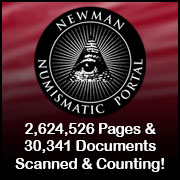
About UsThe Numismatic Bibliomania Society is a non-profit association devoted to the study and enjoyment of numismatic literature. For more information please see our web site at coinbooks.org SubscriptionsThose wishing to become new E-Sylum subscribers (or wishing to Unsubscribe) can go to the following web page link MembershipThere is a membership application available on the web site Membership Application To join, print the application and return it with your check to the address printed on the application. Print/Digital membership is $40 to addresses in the U.S., and $60 elsewhere. A digital-only membership is available for $25. For those without web access, write to: Charles Heck, Treasurer AsylumFor Asylum mailing address changes and other membership questions, contact Chuck at this email address: treasurer@coinbooks.org SubmissionsTo submit items for publication in The E-Sylum, write to the Editor at this address: whomren@gmail.com
BUY THE BOOK BEFORE THE COINSale Calendar
|
- WAYNE'S WORDS: THE E-SYLUM AUGUST 9, 2020
- HALPERN AND PITTMAN SALE PHOTOS OFFERED
- NEW BOOK: GUIDE BOOK OF U.S. PAPER MONEY 7TH ED.
- THE BANKNOTE BOOK SUBSCRIPTION OFFER
- NNP ADDS BALDWIN'S OF ST. JAMES'S CATALOGS
- VIDEO: ABNER KREISBERG INTERVIEW
- MORE ON THE KRAUSE STANDARD CATALOGS
- NOTES FROM E-SYLUM READERS: AUGUST 9, 2020
- VOCABULARY TERM: MODULATED RELIEF
- JOHN JACOB PRICE (1867-19--)
- SUBSCRIBER PROFILE: ROBERT MAISCH
- WAYNE'S NUMISMATIC DIARY: AUGUST 9, 2020
- NEW YORK INTERNATIONAL EDUCATIONAL PROGRAMS
- DETECTORIST FINDS SUFFOLK SILVER COIN HOARD
- STEPHEN AND MATILDA SILVER PENNY OFFERED
- THE KING'S PRIVATE ROAD PASSES
- CATHOLIC UNIVERSITY OF IRELAND ROWING MEDAL
- EARLY BASEBALL MEDALS
- THE HISTORY OF THE 1792 HALF DISME
- THE 1841 QUARTER EAGLE
- ATOCHA BOLIVIAN PHILIP IV SILVER BAR
- THOSE ENIGMATIC S.C. KINGMAN COUNTERSTAMPS
- MAN WINS 1983 ROYAL MINT CONTEST - IN 2020
- ROYAL MINT COMMEMORATES MAYFLOWER 400TH
- WILL THE PENNY SURVIVE CORONAVIRUS?
- THIS ISN'T AMERICA'S FIRST COIN SHORTAGE
- VIRGINIA CHICK-FIL-A COIN DRIVE
- POLAND ISSUES BATTLE OF WARSAW BANKNOTE
- NEW TRINIDAD AND TOBAGO POLYMER BANKNOTES
- FEATURED WEB PAGE: YOUNG NUMISMATISTS
Click here to access the complete archive
Click here to unsubscribe (scroll down)
To comment or submit articles, reply to whomren@gmail.com
Content presented in The E-Sylum is not necessarily researched or independently fact-checked, and views expressed do not necessarily represent those of the Numismatic Bibliomania Society.
WAYNE'S WORDS: THE E-SYLUM AUGUST 9, 2020
 New subscribers this week include:
Jim Donaghy,
Robert Maisch, and
Jim Sandy.
Welcome aboard! We now have 6,545 subscribers.
New subscribers this week include:
Jim Donaghy,
Robert Maisch, and
Jim Sandy.
Welcome aboard! We now have 6,545 subscribers.
Thank you for reading The E-Sylum. If you enjoy it, please send me the email addresses of friends you think may enjoy it as well and I'll send them a subscription. Contact me at whomren@gmail.com anytime regarding your subscription, or questions, comments or suggestions about our content.
This week we open with Krause Publications photo archive offerings, a new book, updates from the Newman Numismatic Portal, and more.
Other topics this week include dealers Abner Kreisberg and John Jacob Price, a subscriber profile, NYINC educational programs, coin hoards, the King's Road passes, a rowing medal, early baseball medals, the 1792 Half Disme, Mayflower quadricentennial coinage, American coin shortages, new banknotes, and the American Association of Young Numismatists.
To learn more about the Herman Halpern collection, the bent half guinea, the Union Asbestos and Rubber Company, the Worthy Coin Corp., modulated relief, National Equitable Labour Exchange notes, Operation Bernhard notes, medals of the War of 1812, the silver penny of Stephen and Matilda, the 1983 Royal Mint National Coin Week competition, the Battle of Warsaw, and the Chick-fil-A coin drive, read on. Have a great week, everyone!
Wayne Homren
Editor, The E-Sylum
HALPERN AND PITTMAN SALE PHOTOS OFFERED
George Cuhaj writes:
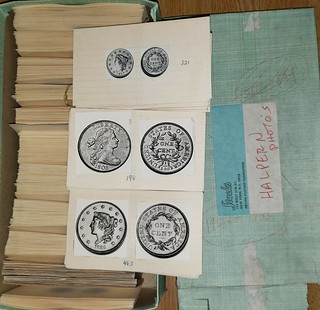 "There are two lots on eBay for the benefit of the Iola Historical Society:
"There are two lots on eBay for the benefit of the Iola Historical Society:
"B&W images from the Stack's sale of Large Cents from the Herman Halpern collection.
"Color 5x7 images from David Akers sales of World Coins from the John J. Pittman sale."
Great research material and numismatic ephemera. -Editor
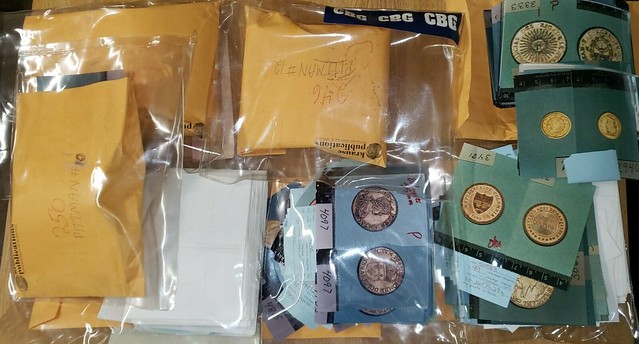
For more information, or to bid, see:
Stack's 1988 Herman Halpern Large Cent Sale B&W original photos - Shoebox Full
(https://www.ebay.com/itm/Stacks-1988-Herman-Halpern-Large-Cent-Sale-B-W-original-photos-Shoebox-Full/373138643622)
Color 5x7 prints from the Akers sale of the John Pittman World Coin sales 850+
(https://www.ebay.com/itm/Color-5x7-prints-from-the-Akers-sale-of-the-John-Pittman-World-Coin-sales-850/373138650159)
To read the earlier E-Sylum article, see:
KRAUSE PUBLICATIONS PHOTO ARCHIVE OFFERED
(https://www.coinbooks.org/v23/esylum_v23n29a02.html)
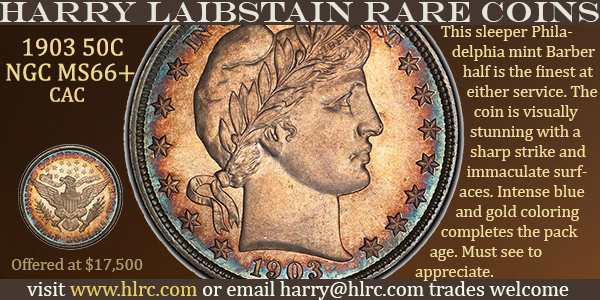
NEW BOOK: GUIDE BOOK OF U.S. PAPER MONEY 7TH ED.
Dennis Tucker of Whitman Publishing submitted this press release about the new edition of the Guide Book of United States Paper Money. Thanks -Editor
Coming in an Updated Seventh Edition
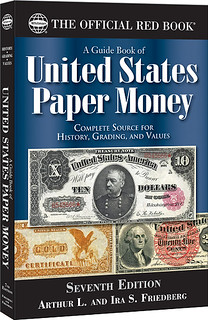 An updated and revised seventh edition of the Guide Book of United States Paper Money will be available in September 2020. The new book is a collector's price guide and history of the paper currency of the United States dating from federal issues introduced during the Civil War to modern-day cash. Written by numismatists Arthur L. and Ira S. Friedberg, the 416-page guide is printed in full color with hundreds of high-resolution images. It retails for $24.95 and will be available online (including at Whitman.com) and from booksellers and hobby retailers nationwide.
An updated and revised seventh edition of the Guide Book of United States Paper Money will be available in September 2020. The new book is a collector's price guide and history of the paper currency of the United States dating from federal issues introduced during the Civil War to modern-day cash. Written by numismatists Arthur L. and Ira S. Friedberg, the 416-page guide is printed in full color with hundreds of high-resolution images. It retails for $24.95 and will be available online (including at Whitman.com) and from booksellers and hobby retailers nationwide.
Thousands of federally issued notes are cataloged in detail in the Guide Book of United States Paper Money. Some are valuable rarities like Gold Certificates and $1,000 Federal Reserve Notes. Others are currency found in our wallets today. An introduction by David L. Ganz explores topics such as grading standards; star notes, the $2 bill, and World War II notes; American money in the Civil War; the Bureau of Engraving and Printing; how cash is designed, printed, and distributed; and how to collect, store, and care for paper money. The book covers every kind of federal paper money printed from the 1860s to today's Series of 2017 Federal Reserve Notes with signatures of U.S. Treasurer Jovita Carranza and Treasury Secretary Steven Mnuchin. The authors review recent developments in the hobby including possible redesigns of the $20, $10, and $5 bills.
On the market side, the book combines the standard Friedberg cataloging system with more than 16,000 retail values in multiple grades for each note.
Regarding today's marketplace, Arthur Friedberg said, “As the seventh edition goes to press, despite the fact that we are still in the midst of the COVID-19 pandemic, there is no lessening of the enthusiasm collectors have for United States paper money. Expensive notes are still setting records, and a plentiful supply of the more common material provides a field day for those wanting to expand their collection.”
The first edition of the Guide Book of United States Paper Money was published in 2005, with updated editions released in 2007, 2010, 2014, 2016, and 2019. It has earned the “Best Specialized Book on United States Paper Money” award from the Numismatic Literary Guild.
Authors Arthur and Ira Friedberg are well known in the numismatic world. They have been professional numismatists for more than 30 years. Both joined their father's family firm, The Coin & Currency Institute, after college. Since then they have established themselves as award-winning authors, coin dealers, researchers, and numismatic consultants to numerous governments and organizations.
The Guide Book of United States Paper Money covers notes from $10,000 down to $1 face value; Treasury notes of the War of 1812; encased postage stamps; Fractional Currency; error notes; signatures on U.S. currency; uncut sheets; and other hobby topics. It includes a glossary and a bibliography for further research.
It may be borrowed for free as a benefit of membership in the American Numismatic Association, through the Dwight N. Manley Numismatic Library. ANA members receive a 10% discount on copies purchased from Whitman Publishing, the Association's Official Supplier.
A Guide Book of United States Paper Money, 7th edition • By Arthur L. and Ira S. Friedberg; introduction by David L. Ganz • ISBN 079484829X • Full color, illustrated • 6 x 9 inches, softcover, 416 pages • Retail $24.95·
URL https://whitman.com/a-guide-book-of-united-states-paper-money-7th-edition/
THE BOOK BAZARRE
THE BANKNOTE BOOK SUBSCRIPTION OFFER
Publisher Owen Linzmayer is offering a great 19% discount on annual subscriptions to The Banknote Book. -Editor

As the entire world continues to grapple with the coronavirus pandemic, many of you have been passing the time with your banknote collections, adding The Banknote Book catalog numbers to your inventories, and double-checking the listing descriptions against actual notes.
I appreciate all the input I've received as a result, including prefix range extensions, replacement notes, and images of new note varieties. Keep those content contributions coming!
Please support The Banknote Book financially by subscribing today.
You'll get immediate access to 291 chapters cram-packed with detailed information to better understand and enjoy your collection, while helping ensure the continued publication of this invaluable numismatic resource.
Enter the coupon code COVID19 to get 19% off annual subscriptions through the end of August 2020. This discount can also be applied to manual renewals even if your subscription does not expire for a while.
Thank you for your kind consideration of this offer. Stay well!
Currently 291 chapters of The Banknote Book have been published as individual high-resolution PDF files. This represents a total of 6,863 pages covering 64,464 types and varieties.
If you've previously purchased any of the above chapters, you are entitled to free revisions of your content for a period of one year following your purchase. As always, subscribers are entitled to all revisions as long as your subscription is valid
To subscribe, see:
https://banknotebook.contentshelf.com/shop

NNP ADDS BALDWIN'S OF ST. JAMES'S CATALOGS
The latest additions to the Newman Numismatic Portal are catalogs of Baldwin's of St. James's. Project Coordinator Len Augsburger provided the following report. -Editor
Newman Portal Adds Baldwin's of St. James's Sale Catalogs
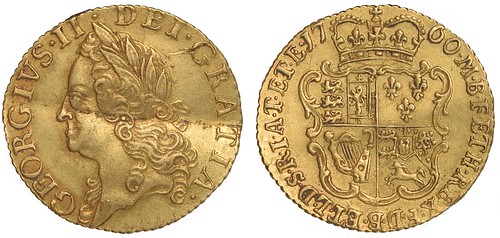
Newman Portal has recently added auction sale catalogs from Baldwin's of St. James's (2017-date), in addition to those of their predecessor, St. James's (2004-2016). Baldwin's of St. James's handles numismatic material from all periods, including ancient, medieval, and modern numismatics. American material occasionally shows up in European sales, and a sampling of these catalogs reveals a number of related lots. Illustrated here is a 1760 George II half guinea, once bent, lot 159 is their upcoming sale no. 47, estimated at 200-250 UK pounds ($263 - $338 USD).
NNP acknowledges Eric Hodge and also Neil Paisley, Managing Director of A. H. Baldwin & Sons, Ltd., for their assistance with this content.
Link to Baldwin's of St. James's catalogs on Newman Portal:
https://nnp.wustl.edu/library/auctioncompanydetail/513621
Link to Baldwin's of St. James's home page:
https://bsjauctions.com/
VIDEO: ABNER KREISBERG INTERVIEW
These are selections from the David Lisot Video Library that feature news and personalities from the world of coin collecting. David has been attending coin conventions since 1972 and began videotaping in 1985. The Newman Numismatic Portal now lists all David's videos on their website at:
https://nnp.wustl.edu/library/multimediadetail/522852
Here's one with dealer Abner Kreisberg. -Editor
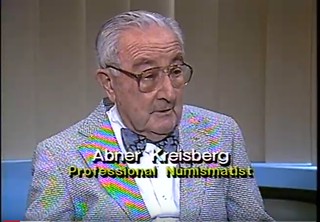 PNG Living History: Abner Kreisberg, July 12, 1988. VIDEO: 21:07.
PNG Living History: Abner Kreisberg, July 12, 1988. VIDEO: 21:07.
Sponsored by the Professional Numismatists Guild.
Abner Kriesberg, Numismatist, David Lisot, Interviewer.
On July 12, 1988 while working at the Financial News Network in Santa Monica, California David Lisot interviews Abner Kreisberg of Beverly Hills, California. Abner shares how he got into the numismatics. He was a friend of Abe Kosoff. He was part of the founding of the Professional Numismatists Guild. He worked with collectors FCC Boyd, Louis Eliasberg and how he helped him get his last coins, and King Farouk and how he collected patterns and what ended up with his collection. Abner talks about what it means to be a collector. He tells the tale of John Beck who had more than 150 gold $50 Slugs. He was chairman of the 1947 American Numismatic Association. He knew B. Max Mehl, Amon Carter, Everyone will enjoy this interview of one of the legends of coin collecting.
An excerpt of the video is available for viewing on the Coin Television YouTube Channel at:
https://youtu.be/QIEKHMWzSwM
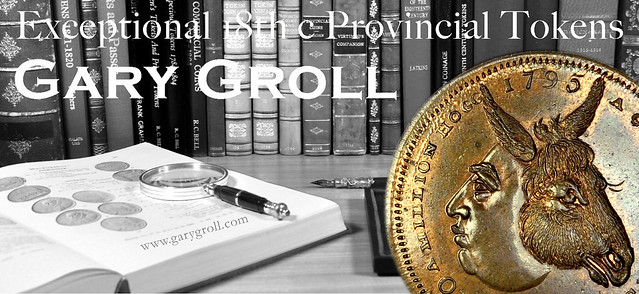
MORE ON THE KRAUSE STANDARD CATALOGS
Pabitra Saha writes:
"The 2020 SCWC 1901-2000 was issued some time back and the 2020 SCWC 2001-date was due on 4th August."
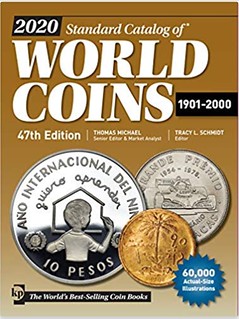
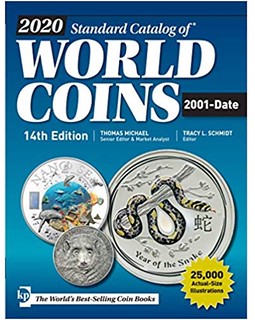
I had been aware of at least one title published post-sale, but it had already been in the production pipeline. I was not aware of any wholly-new editions.
Since these are now Penguin Random House titles, I checked their website but didn't find any 2020 editions. The only SCWC 2001-date edition is the 2019 one published in 2018. If anyone has any information on these, please let us know. -Editor
For Krause Standard Catalog titles on the Penguin Random House site, see:
https://www.penguin.com/search/standard-catalog-of-world-coins?_qry=standard%20catalog%20of%20World%20COins
To read the earlier E-Sylum article, see:
NOTES FROM E-SYLUM READERS: JULY 26, 2020 : Fate of the Krause Standard Catalogs
(https://www.coinbooks.org/v23/esylum_v23n30a12.html)

NOTES FROM E-SYLUM READERS: AUGUST 9, 2020
Col. Nehemiah G. Ordway's Deluxe Heath's Counterfeit Detector
Dave Sundman writes:
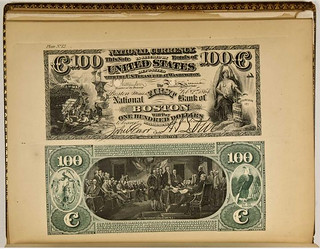 "I am curious as to who offered the Heath's counterfeit detector presentation copy to Col. Nehemiah G. Ordway. Ordway was originally from New Hampshire."
"I am curious as to who offered the Heath's counterfeit detector presentation copy to Col. Nehemiah G. Ordway. Ordway was originally from New Hampshire."
Last week's article discussed the Heather Hardin-Hudson collection of counterfeit detectors. The lot description for a deluxe Heath Counterfeit Detector presented to Secretary of the Treasury Hugh McCulloch mentioned that similar examples were given to other prominent figures including Nehemiah G. Ordway. -Editor
To read the earlier E-Sylum article, see:
HARDIN-HUDSON COUNTERFEIT DETECTION COLLECTION : Lot 94: Presentation Heath Counterfeit Detector
(https://www.coinbooks.org/v23/esylum_v23n31a03.html)
1926 Union Asbestos and Rubber Company Sesquicentennial Medal
Neither Dick Johnson nor Joe Levine were familiar with this particular piece owned by Rachel Proper. She reached out to Dick about it, and he passed it along for our readers. -Editor
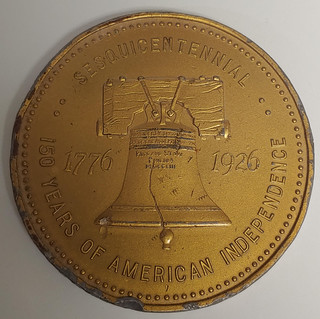
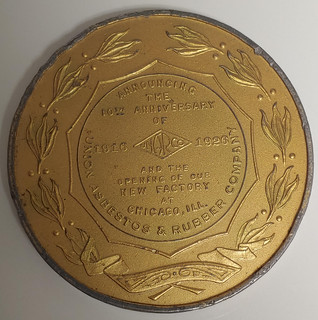
Rachel writes:
"I enjoy coins, tokens and other such things. Recently I purchased at a yard sale a large medallion (about 2.75”). On the front is says 'sesquicentennial 1776 1926 150 years of American independence' The back says 'Announcing the 10th Anniversary of Unarco and the opening of our new factory at Chicago, Ill. Union Asbestos & Rubber Company'
"The front side has a Liberty Bell on it and the back side looks kind of like a wreath border.
"I was wondering where I could find out information about it? And find out if they made copies or if this is original. I have spent some time looking and cannot seem to find one. "
Corporate medals are an under-researched area. Can anyone help? The company went bankrupt after a flurry of lawsuits over the danger of asbestos. Today a firm of the same name manufactures nothing with asbestos but specializes in shopping carts and other store and warehouse equipment. It is part of Warren Buffet's Berkshire Hathaway empire. However, its web site doesn't mention asbestos and traces its history only to 1937. What is the connection, if any? All the more opportunity for someone to do some research on this piece. I checked with researcher Harry Waterson who writes: "Asbestos companies are hard to research. You get a lot of hang-ups. I found a couple of librarians in New Jersey who kept vertical files of asbestos companies that had plants in NJ." -Editor
To visit the Unarco website, see:
https://www.unarco.com/index.html
1958 Worthy Coin Corp. Catalog
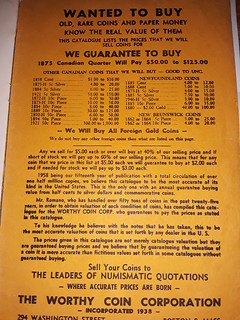 Web site visitor Greg Richardson of Odessa, TX writes:
Web site visitor Greg Richardson of Odessa, TX writes:
"I have a coin catalog from The Worthy Coin Corp. from 1958: 294 Washington St. Boston 8, Mass. The booklet mentions being incorporated in 1938.
My Mom has had this booklet forever and gave it to me. In 1958 I was 5 yrs old. Wish my parents would have bought all the coins possible."
Thanks. At my request Greg passed along an image. Thanks. A nicely preserved copy. -Editor
To read earlier E-Sylum articles, see:
DON CORRADO ROMANO (1903-1984)
(https://www.coinbooks.org/v21/esylum_v21n40a12.html)
WORTHY COIN COMPANY START DATE
(https://www.coinbooks.org/v21/esylum_v21n41a11.html)

VOCABULARY TERM: MODULATED RELIEF
Dick Johnson submitted this entry from his Encyclopedia of Coin and Medal Terminology. Thanks. -Editor
Modulated Relief. The rise and fall of three-dimension sculptural surface; the total surface planes and curvatures forming a coin or medal design. Modulated relief is created during the step of modeling a design. It is formed by adding material, or carving it away, the function of modeling. The purpose of the model – irrespective of its media, clay, wax, plaster, wood, whatever, or its size – is to convey a surface to a manufacturer who will render this surface, usually by reduction, into a die or mold which to reproduce the coin or medal.
Containing the undulating relief that forms the design, devices and lettering, modulated relief is the surface of the model or pattern, its three-dimensionality gives the object its configuration and shape. It is the warp and wave of the design, or to permit a further alliteration, it is a “configuration of contours.” This is the bas-relief design that is reproduced by pantographic reduction or copied by hand engraving or forming the pattern to be replicated in some manner to create the end product or object.
(The author began using this term in 1974 and has continued to do so in his writings ever since. The term so aptly describes the exact meaning indicated. It can be applied to model, pattern, die – the struck or cast piece – that is instantly recognizable by any viewer or reader.)
Looking for the meaning of a numismatic word, or the description of a term? Try the Newman Numismatic Portal's Numismatic Dictionary at: https://nnp.wustl.edu/library/dictionary
Or if you would like a printed copy of the complete Encyclopedia, it is available. There are 1,854 terms, on 678 pages, in The Encyclopedia of Coin and Medal Technology. Even running two a week would require more than 19 years to publish them all. If you would like an advance draft of this vital reference work it may be obtained from the author for your check of $50 sent postpaid. Dick Johnson, 139 Thompson Drive, Torrington, CT 06790.
JOHN JACOB PRICE (1867-19--)
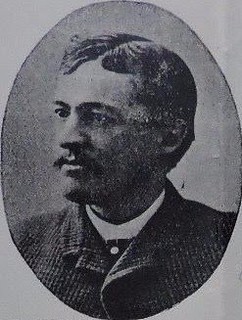 John Jacob Price had more than one iron in the fire. He simultaneously worked as a travel agent, paint & glass dealer, and sold coins, stamps, curios, Indian relics, eggs, and guns.
John Jacob Price had more than one iron in the fire. He simultaneously worked as a travel agent, paint & glass dealer, and sold coins, stamps, curios, Indian relics, eggs, and guns.
He was born in September 1867 in Missouri. His father was from England, and his mother was a native of Vermont.
In 1889, he married Sarah (1876-), a native of Illinois.
According to the U. S. Census 1900, the same address as printed on his letterhead : 1322 Seventh Street, Des Moines Iowa. The Census reports that he was married eleven years, and worked as a commercial travel agent, and sold paint and oils. The city directories from 1896 on consistently list him as a travel agent. His business envelopes are commercial advertisements selling paint and oils.
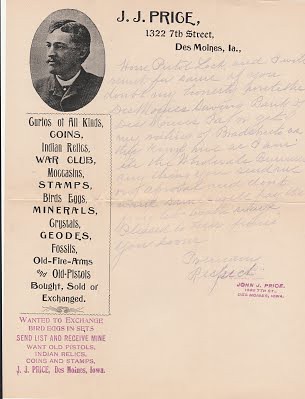 His main career was in some respects similar to his numismatic contemporary Ralph Randolph Barker (1856-1913), where Price was engaged in both selling paint and oils and glass. His sideline was selling curios, coins, Indian relics, guns, and so forth.
His main career was in some respects similar to his numismatic contemporary Ralph Randolph Barker (1856-1913), where Price was engaged in both selling paint and oils and glass. His sideline was selling curios, coins, Indian relics, guns, and so forth.
He applied for membership in the ANA in December 1900 and became ANA Member No. 229. He was a contemporary of Harry Wyman Tapley (1863-1939), a fellow numismatist and member of the ANA active in Des Moines, Iowa.
He ran two advertisements in the January 1902 issue of The Oologist, wanting to exchange birds eggs in sets, and in the other advertisement wants old pistols, coins, stamps and Indian relics.
He is listed as a member of the American Society of Curio Collectors, when Thomas L. Elder was vice-president, and is listed as part of the recruiting members in the February 1903 issue of Philatelic West, Vol. XXII, No. 2.
To read the complete article, see:
PRICE, JOHN JACOB
(http://www.numismaticmall.com/numismaticmall-com/price-john-jacob)

SUBSCRIBER PROFILE: ROBERT MAISCH
New Sunday subscriber Robert Maisch provided this numismatic profile. Thanks, and welcome aboard! -Editor
I'm a member of the ANA (LM 1717), TAMS, CSNS, NENA, South Dakota Coin and Stamp Association and Bridge City Coin and Stamp Club of Mobridge, SD. I was receiving The E-Sylum through the ANA and I shared it with some of the South Dakota movers and shakers so you may get some others from South Dakota wanting to be on the list.
I'm US Navy Retired (1956 to 1976), I joined the ANA IN 1971 and my late wife Cheryl joined in 1975. Cheryl passed away March 3, 2018. We have received the Glenn Smedley Award, a Presidential Award and the Medal of Merit. We were always active in the ANA National Coin Week activities. We were both ANA Certified Judges.
Stationed in Hawaii, I was Treasurer and then President of the Hickam Area Coin Club. Both Cheryl and I served on the Hawaii State Numismatic Association Board. Upon our departure we were recognized with Honorary Life Memberships #1 and #2.
Cheryl was Librarian of the Token and Medal Society (TAMS) for 15 years prior to Peter Irion. TAMS selected two of my design concepts for their medals We were both honored to become Numismatic Ambassadors.
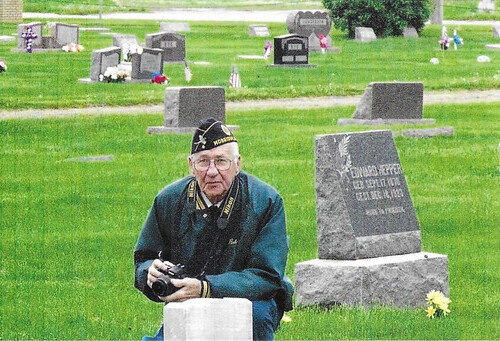
Robert Maisch Memorial Day 2020
While in Maine we were President and Secretary/Treasurer and conducted the Spring and Fall Shows. For NENA we served on the Board, were President and Vice President the year Maine clubs hosted a NENA Convention. NENA has selected four of my design concepts for its annual convention medals.
In South Dakota we were editors of the SDC&SA newsletters, which I do solo now. For the local Mobridge club I chair the NCW activities with the help of several retired teachers and club members. Our design contest entries range from 214 to 245 student participants. We prepare numismatic and historical questions for KOLY, the local radio station, during NCW The club donated books to the A.H. Public Library during NCW and now with gifts from dealers like P. Cunningham, S. Miedema, V. Binfet, the club and others, the library now has the largest number of numismatic and philately related books in the state. The books cover all age groups and levels of experience.
In 2019, members, for its 100th Anniversary of the Parker-Browder American Legion Post 4, asked and approved my design concept for their medal of which we now have about a dozen left.
I am very proud to be part of this community.
THE BOOK BAZARRE
WAYNE'S NUMISMATIC DIARY: AUGUST 9, 2020
Two weeks ago I discussed a few items I've consigned to the upcoming Stacks Bowers August sales. Here are a couple group lots of interesting paper money we've discussed before.
Lot 31190: National Equitable Labour Exchange Notes
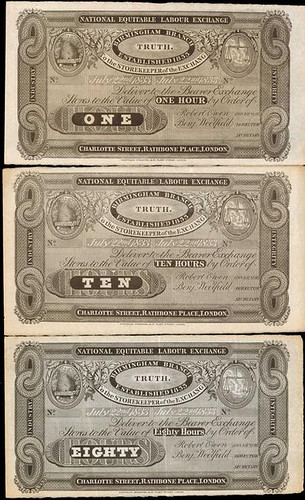
GREAT BRITAIN. National Equitable Labour Exchange. 1, 10 & 80 Hours, 1833. P-Unlisted. Very Fine.
A trio of Very Fine Labour Exchange notes, one is for one hour, another for ten and the last for eighty hours. Found with toning and edge wear.
Labor notes were a unique monetary experiment in early nineteenth-century England. They bore a face value equivalent to a certain number of hours of work. The notes were the brainchild of Robert Owen, a successful textile manufacturer who rose to fame as a utopian socialist reformer.
Please do bid if you have any interest in this material. The sale closes tomorrow, August 10, 2020. Don't let these go cheap and wish you'd placed a bid. -Editor
From the January 2017 article by Grant Shobar in The Numismatist:
"Although the notes were issued in many different denominations and used successfully for almost three years, they are only occasionally seen at auction today. It is unknown whether this is because the bills reside in personal collections, were redeemed, or were lost or destroyed. Whatever the case, notes are quite rare and finding one is extremely difficult, regardless of condition."
These notes are indeed hard to find and these three different denominations comprise my complete collection. They were a forerunner of the of the Labor Exchange notes produced in the U.S. by Italian immigrant G. B. De Bernardi. -Editor
To read the complete lot description, see:
GREAT BRITAIN. National Equitable Labour Exchange. 1, 10 & 80 Hours, 1833. P-Unlisted. Very Fine.
(https://auctions.stacksbowers.com/lots/view/3-NKPGN/great-britain-national-equitable-labour-exchange-1-10-80-hours-1833-p-unlisted-very-fine)
To read earlier E-Sylum articles, see:
ROBERT OWEN'S LABOR EXCHANGE CURRENCY
(https://www.coinbooks.org/v20/esylum_v20n01a31.html)
LABOR EXCHANGE NOTES
(https://www.coinbooks.org/esylum_v09n49a20.html)
Lot 31193: Operation Bernhard Counterfeits
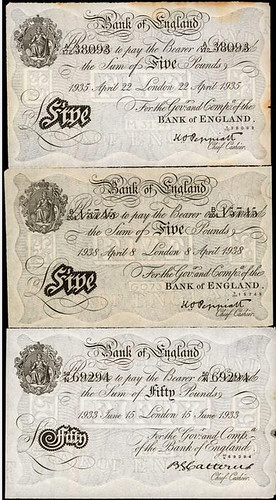
GREAT BRITAIN. Bank of England. 5 to 50 Pounds, 1942-44. P-336B. Operation Bernhard Counterfeits. Very Fine.
5 pieces in lot. A grouping of forgeries committed by Nazi Germany under Operation Bernhard. Included are two 5's, two 10's and a 50 Pound note.
Operation Bernhard was the name of a secret German plan during World War II to forge Bank of England notes using a team of counterfeiters chosen for their skills from among inmates at concentration camps. The story was made into a feature film, The Counterfeiters. This is my collection of five different examples of these fascinating relics; all but the 1935 note were acquired in 2007 in London from Colin Narbeth & Son. The sale closes tomorrow, August 10, 2020. -Editor
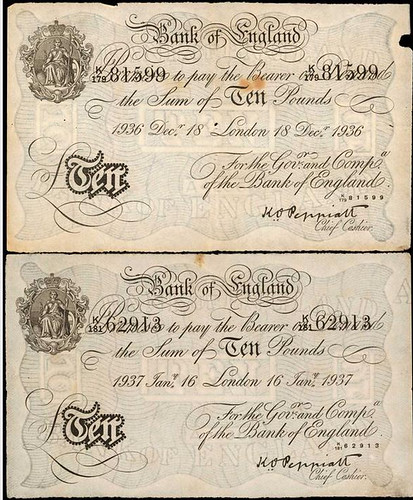
To read the complete lot description, see:
GREAT BRITAIN. Bank of England. 5 to 50 Pounds, 1942-44. P-336B. Operation Bernhard Counterfeits. Very Fine.
(https://auctions.stacksbowers.com/lots/view/3-NKPGU/great-britain-bank-of-england-5-to-50-pounds-1942-44-p-336b-operation-bernhard-counterfeits-very-fine)
To read earlier E-Sylum articles, see:
OPERATION BERNHARD COUNTERFEITER ADOLF BURGER INTERVIEWED
(https://www.coinbooks.org/esylum_v12n10a24.html)
ARTICLE HIGHLIGHTS NAZI OPERATION BERNHARD COUNTERFEIT BANKNOTE
(https://www.coinbooks.org/esylum_v13n40a21.html)
KEY INFORMATION SOURCES ON OPERATION BERNHARD
(https://www.coinbooks.org/esylum_v10n05a23.html)
FEATURED WEB SITE: OPERATION BERNHARD
(https://www.coinbooks.org/esylum_v19n50a37.html)
To read my earlier Numismatic Diary articles, see:
WAYNE'S NUMISMATIC DIARY: JULY 26, 2020
(https://www.coinbooks.org/v23/esylum_v23n30a22.html)
WAYNE'S NUMISMATIC DIARY: AUGUST 2, 2020
(https://www.coinbooks.org/v23/esylum_v23n31a24.html)

NEW YORK INTERNATIONAL EDUCATIONAL PROGRAMS
The New York International Numismatic Convention has announced a partial schedule of educational events for the planned January 2021 show. Here's the press release. -Editor
Partial Educational Program Schedule
 Kevin Foley, Bourse Chairman for the 49th Annual New York International
Numismatic Convention, has announced the content of several of that event's
educational programs. Foley said: “We always strive to have a broad range of
educational programs on Saturday so that our convention will be a focused
educational experience as well as a collecting opportunity for our attendees. At 10AM on Saturday, January 16 the executive director of the Ancient Coin Collectors Guild, attorney Peter K. Tompa will present Cultural Property Update 2020: The Year in Review. Mr. Tompa's annual presentations exploring this subject matter are an especially popular and well attended feature of our educational programs. Later Saturday afternoon Joel Iskowitz will be the keynote speaker at our 1PM-3PM program for Young Numismatists. As in the past, the YN program will be moderated by Jack Mattes, president of the American Association of Young Numismatists.
Kevin Foley, Bourse Chairman for the 49th Annual New York International
Numismatic Convention, has announced the content of several of that event's
educational programs. Foley said: “We always strive to have a broad range of
educational programs on Saturday so that our convention will be a focused
educational experience as well as a collecting opportunity for our attendees. At 10AM on Saturday, January 16 the executive director of the Ancient Coin Collectors Guild, attorney Peter K. Tompa will present Cultural Property Update 2020: The Year in Review. Mr. Tompa's annual presentations exploring this subject matter are an especially popular and well attended feature of our educational programs. Later Saturday afternoon Joel Iskowitz will be the keynote speaker at our 1PM-3PM program for Young Numismatists. As in the past, the YN program will be moderated by Jack Mattes, president of the American Association of Young Numismatists.
The 3PM meeting slot will feature Gilles Bransbourg, Ph. D., the executive director of the American Numismatic Society on Inflation and Coinage Reform in the 4th Century Roman Empire. Dealer John Kraljevich will follow at 4PM Saturday speaking on British and American Medallic Issues Related to the War of 1812 before the British Numismatic Society.”
Foley continued: “Our Saturday presentations, under the auspices of numismatic organizations that have supported the NYINC for many years, are a veritable graduate level day long seminar of numismatic scholarship and research. We'll be adding more programs and speakers in the near future and encourage periodic visits to our website, www.nyinc.info, to keep updated.”
The NYINC bourse, focused exclusively on world and ancient numismatics and United States issues before 1815, will take place Thursday through Sunday, January 14-17 in the Empire Ballroom of the Grand Hyatt New York, located at 109 East 42nd Street, between Park and Lexington Avenues. The Grand Hyatt is directly connected to Grand Central Station, served by the Metro North commuter rail system as well as multiple subway lines. Room rates at the Grand Hyatt begin at $209. Reservations can be made via a link for that purpose on the event website.
Great lineup! -Editor
For more information, see:
www.nyinc.info
To read the earlier E-Sylum article, see:
2021 NEW YORK INTERNATIONAL CONVENTION
(https://www.coinbooks.org/v23/esylum_v23n29a14.html)
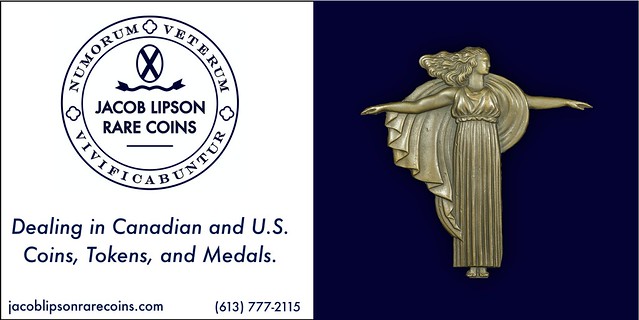
DETECTORIST FINDS SUFFOLK SILVER COIN HOARD
Tom Kays passed along this article about a metal detectorist who uncovered a hoard of over 1,000 silver coins from the English Civil War era. Thanks! Great story. -Editor
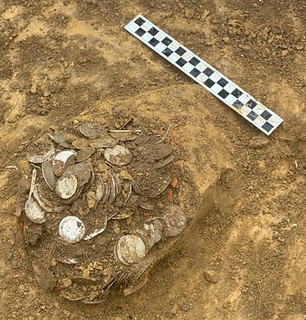 A metal detectorist unearthed the ‘biggest haul of his life' when he discovered more than 1,000 silver coins estimated to be worth £100,000 near a Suffolk pub.
A metal detectorist unearthed the ‘biggest haul of his life' when he discovered more than 1,000 silver coins estimated to be worth £100,000 near a Suffolk pub.
Luke Mahoney, 40, and two of his friends stayed up for three nights straight last week as they searched a field behind the Lindsey Rose pub, Lindsey, after the landowners, Charlie and James Buckle, granted him permission.
Starting at 10am on Sunday, July 26 with his friends Dan Hunt and Matt Brown, Mr Mahoney scoured the 15-acre field and first found a gold coin and sixpence before taking a break for lunch.
However, upon their return to the field the trio began discovering coins “everywhere”, as well as a cracked clay earthenware pot.
They stayed up over three nights keeping watch over the field to prevent ‘nighthawks' - rival detectorists hoping to loot valuable sites in the dark - from capitalising on their find.
Overall, the group unearthed 1,061 silver hammered coins dating back to somewhere in the 15th to the 17th century, according to experts.
Valuation expert Nigel Mills examined some of the coins found and said the hoard would fetch at least £100,000 at auction.
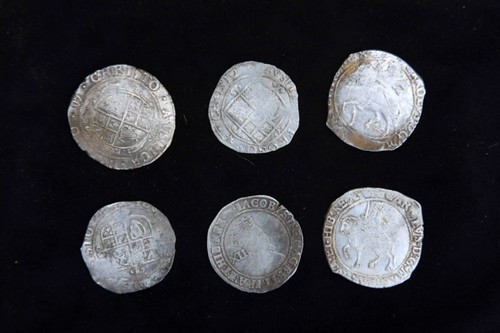
He said the earliest coin was an Elizabeth I era shilling dating back to 1573-78, with the find also containing many Charles I half crowns from 1641-43.
Mr Mahoney said he searched the field for the “rush” and compared the feeling of discovering a huge haul to catching a big fish.
“We went back out to the fields and almost immediately I hit this signal and I pulled out this Charles I coin. Then I hit another signal, and another.
“They were everywhere. It was pandemonium. After ten minutes of searching I hit this massive signal and I thought ‘this is it'.
“We dug and saw the pot. That feeling of scraping the dirt away and seeing the coins is indescribable.
To read the complete article, see:
Civil war-era coins worth £100,000 unearthed in field behind pub
(https://www.eadt.co.uk/news/suffolk-metal-detectorists-hal-worth-100000-lindsey-rose-1-6774305)
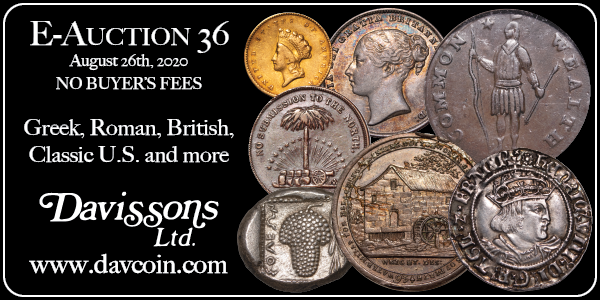
STEPHEN AND MATILDA SILVER PENNY OFFERED
Dix Noonan Webb are offering a very rare silver penny in their September sale. Here's the press release. -Editor
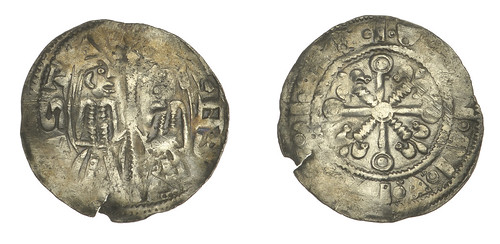
An extremely rare silver penny of Stephen and his wife Matilda – who fought with his cousin the Empress Matilda for the throne in the 12th Century - is to be offered by International coins, medals, banknotes and jewellery specialists Dix Noonan Webb in a live/online auction of British and World Coins on Wednesday, September 16, 2020 at 11am on www.DNW.co.uk .
Discovered by metal detectorist Graeme Rushton on October 20, 2018 on the border of South Yorkshire and Lincolnshire, using a Teknetics G2+ metal detector, the coin is one of only 25 known specimens and is estimated to fetch upto £10,000.
Graeme who is 50-years-old and lives in South Cumbria, has been detecting since he was 8- years-old, and ten years ago, he decided to start his own shop called Unearthed, which sells metal detectors.
As Graeme explains: “It was only my second visit to the site which had just been ploughed and flattened. After about 45 minutes walking up a slight rise in the field, I got a signal, and after digging down 5-6 inches, I uncovered the coin which at first I didn't recognise. It was only after showing pictures of it to the Fitzwilliam Museum in Cambridge that I realised how significant the discovery was.”
The coin has on the obverse the legend “STIENS” with standing figures of Stephen and Matilda facing each other supporting a tall sceptre between them, while on the reverse is a cross fleury over cross pommee with various ornaments around. The coin was minted in York in the early 1140s and is in very fine condition.
Stephen of Blois was the grandson of William I, and became King of England on December 22, 1135 to his death in 1154. For almost all of the 19 years of his reign a civil war raged with his cousin Matilda, with the English Royalist Barons supporting him while the Angevin French supporters backed Matilda, who was the daughter of Henry I of England who had nominated her as heir to the throne. Stephen however claimed that his uncle had changed his mind on his deathbed recognising Stephen as his successor.
The find-spot was not far from where the Battle of Lincoln took place in February 1141 between Stephen and Matilda's half brother Robert, Earl of Gloucester, Stephen was defeated, captured and imprisoned for six months in Bristol Castle before an exchange enabled him to be released. In 1153, Stephen agreed to accept Matilda's son Henry as his heir, thus ending the conflict which has become known as the Anarchy.
For more information, see:
https://www.dnw.co.uk/auctions/
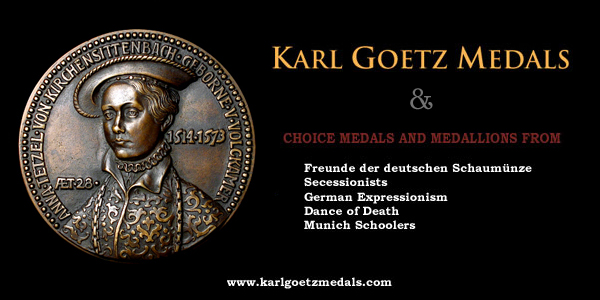
THE KING'S PRIVATE ROAD PASSES
Over on the Colonial Coins mailing list this week Bruce H. Smith posted a note about a couple interesting recent acquisitions. -Editor
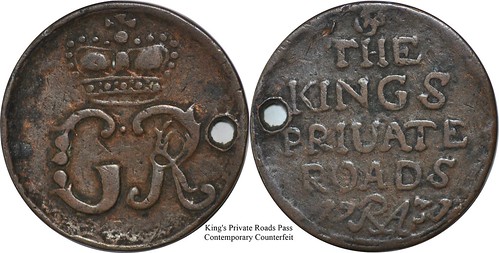
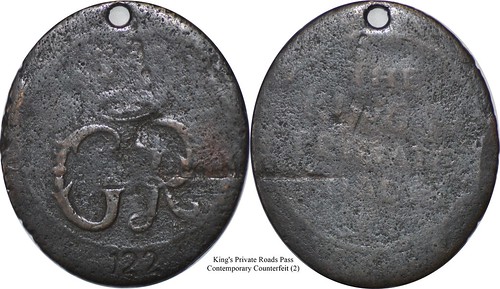
I'll introduce a topic that, while period, isn't colonial; King's Private Roads passes. I had never heard of them until I noticed a run of them in the last CNG sale. I bought a lot consisting of two counterfeits. Antony Wilson of York Coins describes them on his site as follows:
"The King's Private Road ran between the two royal palaces of St. James's Palace, to the west of the City of London to Hampton Court further upstream on the Thames at Richmond, a distance of about 11 miles.. The route is presently followed by the current line of the King's Road in Chelsea, in the later seventeenth century and eighteenth century the road ran through fields and market gardens growing produce for the London urban market.
The regal name given to the road dates from the reign of Charles II (1660-1685) who made it a private road closed to public transport. During the reign of George II limited access to the route was given to local tenants and notables with passes being made available for a modest fee. Fees from the sale of passes were used to pay the gatekeepers employed to regulate traffic on the road and for the road repairs. "
These were Lot 597 in the York Coins inventory. So the counterfeit passes were I guess the 18th century equivalent of an inflatable doll for the passenger seat enabling free admission to the carpool lane. Neat items, genuine or counterfeit. -Editor
Craig McDonald pointed to a group of these passes at the British Museum:
https://www.britishmuseum.org/collection/search?agent=King%27s%20Private%20Roads
Jeff Rock added:
"There have been several talks on these at the Token Congress in the UK - they are popular, as are theater tokens (same concept, the token is bought or given to a favorite and they get into see any play, any time - some of the theaters are still in existence 200+ years later, and I've often wondered what would happen if I took one of the tokens in! Most were for the year or season, but some were lifetime passes). They are definitely cool items, but as I've always said, one is an oddity, two is a trend, three is a collection. You are right at the edge!
"if I remember right the BM got the Montague Guest collection as a donation, which was one of the largest ever formed. There's a catalogue of that collection which was pretty much a reference work for the better part of a century. The series is covered in the Withers Token Book 3."
Craig McDonald writes:
"And here's a blog with some good info, including the names of the individuals whose initials appear between the numerals of the date.."
Topic: KINGS PRIUATE ROADS bronze pass
(http://www.worldofcoins.eu/forum/index.php?topic=16908.0)
Bruce notes that another group of King's Private Road tokens begins at Lot 586 in the Classical Numismatic Group's recent eAuction 473. Thanks. -Editor
To visit the York Coins site, see:
http://www.yorkcoins.com/
To view the CNG lots, see:
https://auctions.cngcoins.com/auctions/4-MVFEK/electronic-auction-473?limit=48&jump_to_lot=586
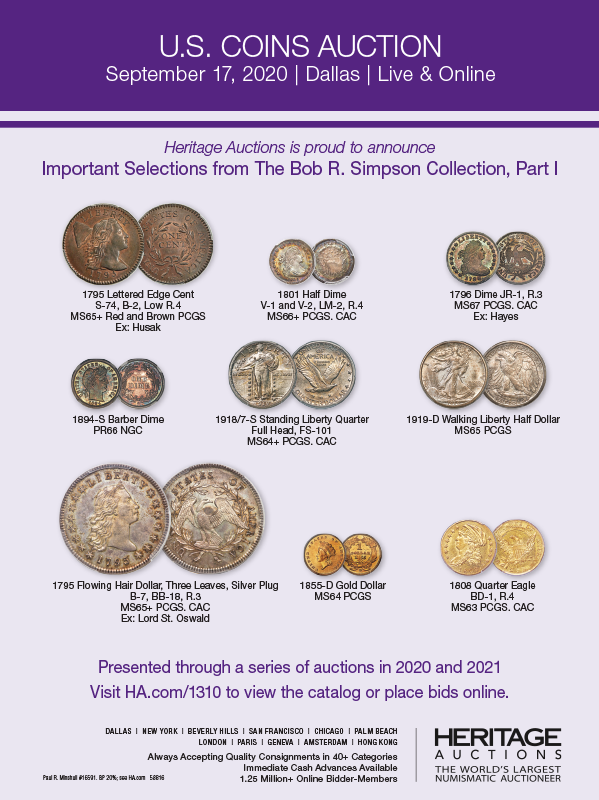
CATHOLIC UNIVERSITY OF IRELAND ROWING MEDAL
Here's an article I came across this week about an interesting university rowing club medal. -Editor
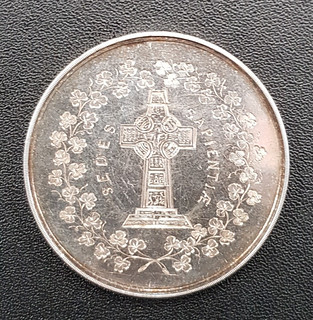
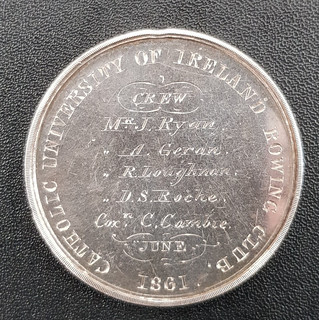
I purchased this un-hallmarked medal in August 2008 thinking that I would have some fun finding out about a club that I had previously never heard of, and about a university that had barely registered with me. My not insignificant efforts to discover more about the club or the crew has not unearthed a single piece of additional information than what is engraved on the medal itself. In truth, no matter how hard I strained at the oars, the wind was against me.*
The medal weighs 35 grams and the seller had it professionally troy tested in three different areas, and each indicated sterling silver. The obverse is engraved with a Celtic High Cross and the motto SEDES SAPIENTIÆ surrounded by a garland of shamrocks. The reverse identifies the club and its crew and dates the medal to June 1861.
University education in Ireland between 1592 and 1845 was the sole preserve of The University of Dublin and its single constituent college, Trinity College. Rowing amongst undergraduates and associates began there in 1836 and in various guises, they dominated rowing in Ireland for much of the next century. Catholics were permitted to study there from the 1780s, with further restrictions removed in the 1870s. However, the Hierarchy of the Catholic Church refused to allow its flock to attend.
The Government addressed this in 1850 by founding the Queen's University of Ireland by amalgamating three existing Queen's Colleges: Belfast, Cork, and Galway (all founded in 1845), as a non-secular university. This did not satisfy the Church leaders and in 1851, they established the Catholic University of Ireland, a private university that opened its doors to students in 1854 under the leadership of John Henry Newman, a convert from the Church of England and a future Cardinal.
Seventeen students attended the first lectures in 1854 but as a private university without a royal charter it could not award degrees. Newman left the university in 1857 believing its purpose was just a political weapon to be used against the Queen's University. Following his departure, the university declined rapidly and in 1879 only three students registered.
In 1880, the Royal University of Ireland was founded as a degree-awarding institution whose exams could be taken by anyone including those who attended other educational establishments. This notable change prompted the Catholic University to reinvent itself as University College, Dublin, and immediately its downward spiral was reversed.
UCD began its rowing life in 1917 when students formed UCD Rowing Club boating out of Commercial Rowing Club in Ringsend. As it expanded, the fledgling club moved next door into Dolphin Rowing Club (1919), joined the I.A.R.U. in 1922 and in 1926 it changed its name to UCD Boat Club. In 1928, they joined the exodus to Islandbridge.
I passed this along to reader John Sallay, who collects school and University academic medals. -Editor
John writes:
"Interesting medal with a terrific write-up on the history of the various Irish colleges and universities. This is just a microcosm of the much broader battle within the Christian world over the last five centuries between Catholics and Protestants over the minds of and values of young people.
My collecting scope does not include athletics so I don't know much and don't have anything to add about this rowing medal. "
To read the complete article, see:
Greg Denieffe: A Devotional Medal, of Sorts
(https://heartheboatsing.com/2020/07/28/greg-denieffe-a-devotional-medal-of-sorts/)
Thanks. So many areas of numismatics remain under-researched. Opportunities await future authors. -Editor

EARLY BASEBALL MEDALS
Allan Davisson highlighted two interesting medals in the upcoming Davisson's E-Auction 36. I'd been wanting to mention these anyway, so here are Allan's comments followed by the two lot descriptions. -Editor
The last two pieces in the sale are from an earlier—but not forgotten—era in baseball. When I was a pre-teen and beyond, baseball was the only nationally celebrated sport. The NHL and the NFL were established but were far from the national dominance they have in today's sports world. But baseball…I grew up in a town with a Dodgers (Brooklyn) farm team. We followed the Dodgers avidly. When World Series time came our classroom time was sometimes interrupted by an update on the score. The closest parallel to baseball enthusiasm in that era is probably today's NCAA Final Four playoffs.
Baseball is the American game that inspired “Field of Dreams.” These two medals bring back a golden moment of nostalgia. It seemed particularly fitting to include them in this sale as baseball struggles to play yet another season.
Lot 201: 1913 Base Ball Tournament Medal
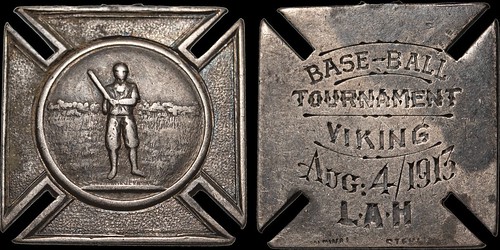
UNITED STATES. A medal in the form of a silver cross. 10.82 gm. 27 x 27 mm. 1913. A raised circle showing baseball player in a uniform of the era holding a bat / Engraving in five lines; BASEBALL TOURNAMENT VIKING AUG 4, 1913. LAH. Very Fine; a handsome silver medal with careful engraving. It looks to have once had a loop on top that is now gone. Viking tournament? One can still find tournaments with this name, but where this one was held is a good question.
This is a first-seen for me. Interesting and unusual piece. -Editor
To read the complete lot description, see:
E-Auction 36 Lot 201
(https://davcoin.com/lot/e-auction-36-lot-201)
Lot 202: Base Ball Fan 1915 Medal
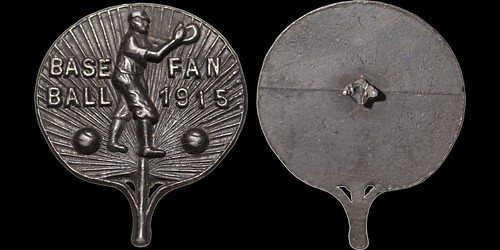
UNITED STATES. Fan shaped medallet. 4.56 gm. 27 x 32 mm. 1915. A ball player in a uniform of the era, catching a ball; BASE BALL FAN 1915 / Blank, remains of a means of attachment. Extremely Fine.
For baseball fans in a time of seriously diluted baseball: two mementos of a classic era (lots 201 and 202). The 1910s decade was a golden age of baseball: Ty Cobb, Honus Wagner, Christy Mathewson, Tris Speaker, "Shoeless" Joe Jackson—names that are still familiar to baseball fans were among the players who dominated this decade. 1913 and 1915 were happy baseball years. (It all came crashing down in the 1919 World Series. We are not the first to experience a loss of innocence about the game.)
Another neat item. I'd never seen this one before, either. -Editor
To read the complete lot description, see:
E-Auction 36 Lot 202
(https://davcoin.com/lot/e-auction-36-lot-202)
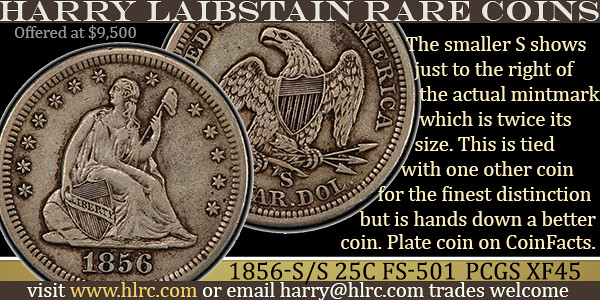
THE HISTORY OF THE 1792 HALF DISME
In July the American Numismatic Association posted on the ANA blog an article on the history of the 1792 Disme. Originally published in The Numismatist August 2017, it was written by Pete Smith, Joel J. Orosz & Leonard Augsburger and won the Heath Literary Award that year. Here's a short excerpt - the complete article is available online. -Editor
A MORE ACCURATE HISTORY OF THE 1792 HALF DISME
A tale of three sources, two strikes and one president.
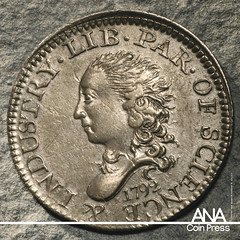 The first 1,500 coins of the infant United States Mint came off the press in the late-18th century and almost immediately disappeared from view. Centuries after its modest debut, that revolutionary emission—the 1792 half disme—is shrouded in mystery: Was it struck at the Philadelphia Mint or in the cellar of a mint contractor? Was it produced in Summer 1792, prior to the mint's opening, or in October of that year, after operations began? Were the half dismes meant to be patterns to secure design approval, or were they business strikes, intended for circulation? Who provided the bullion for their production, President George Washington or someone lesser known? If it was Washington, did he donate his personal silverware or silver bullion in some other form?
The first 1,500 coins of the infant United States Mint came off the press in the late-18th century and almost immediately disappeared from view. Centuries after its modest debut, that revolutionary emission—the 1792 half disme—is shrouded in mystery: Was it struck at the Philadelphia Mint or in the cellar of a mint contractor? Was it produced in Summer 1792, prior to the mint's opening, or in October of that year, after operations began? Were the half dismes meant to be patterns to secure design approval, or were they business strikes, intended for circulation? Who provided the bullion for their production, President George Washington or someone lesser known? If it was Washington, did he donate his personal silverware or silver bullion in some other form?
Two seemingly authoritative sources that surfaced during the mid-19th century provided answers to these questions. They corroborated some assertions and contradicted others. Inevitably, collectors, dealers and scholars chose sides and argued for 150 years about which source was more credible and which story was more plausible. Unbeknownst to these bickering numismatists, however, the definitive answers to these vexing questions were recorded by a third and very reliable source. Information from that reference dribbled out slowly between 1966 and 2003, and glimpses of the story emerged. However, it was not until we thoroughly examined this third source that a more accurate history of the half disme could, for the first time, be revealed. The “extended version” of that history, along with that of the other 1792-dated coins, appear in our book 1792: Birth of a Nation's Coinage, published in 2017 by the Ivy Press, a subsidiary of Heritage Auctions.
The story of the half disme begins with its obscure gestation, striking and distribution. When it was struck in 1792, hardly anyone took notice. No announcement was made, no “first strike” ceremony was recorded, and not a single newspaper in Philadelphia, or anywhere else, covered the story. Modest in appearance and comparatively few in number, the half dismes vanished from the scene just as quietly as they arrived.
Over the next 40 years, pioneering coin collectors encountered, every now and again, tiny silver U.S. 5-cent pieces that carried the peculiar word “disme.” They wondered about the whys and wherefores of these enigmatic coins, but in the early 1830s, numismatic knowledge was sparse. No books or magazines focused on American coins; no coin clubs existed; written records were scattered; and collectors toiled in isolation. An enterprising numismatist might have contacted mint personnel to seek information, but by the early 1830s, all of the men who had worked on the first federal coinage of 1792 were long since dead, leaving only the faintest of paper trails.
The first collectors who added half dismes to their cabinets, therefore, could only admire them in wonderment. A few were more proactive. In 1838, for instance, William G. Stearns of Boston wrote to Mint Director Robert M. Patterson, asking for a detailed description of the all-but mythical 1792 half disme. Patterson obliged by sending basic information about the piece, but enclosed no illustration.
At the end of the 1830s, at long last, the flywheel of numismatic knowledge slowly started to turn. In 1839 the Reverend Joseph B. Felt wrote the first American book with significant numismatic content, An Historical Account of the Massachusetts Coinage. Three years later, U.S. Mint Assayers Jacob B. Eckfeldt and William E. Dubois produced A Manual of Gold and Silver Coins of All Nations, featuring engraved illustrations. Half dismes had disappeared from circulation by 1842, so the manual did not mention them. Dubois was back in print in 1846 with Pledges of History, a guide to the mint's coin cabinet. He was the first author to mention the 1792 half disme, thus confirming its genuineness, but since the book was not illustrated, collectors still wondered what the piece looked like.
Finally, in 1857, as coin collecting was experiencing a boom, Norton's Literary Letter (a periodical for bibliophiles) published the first engraving of this petite 5-cent piece. And, 67 years after the half dismes were struck, Dr. Montroville Wilson Dickeson, the “Indiana Jones” of his day, wrote the first comprehensive guide to the hobby, The American Numismatical Manual. Quaint though Dickeson's spelling might have been, his technology was fairly sophisticated, for his book included 19 plates of tinted facsimile illustrations, including a half disme. Collectors at last had basic information and images for reference.
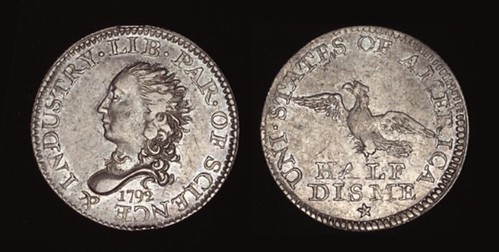
To read the complete article, see:
A MORE ACCURATE HISTORY OF THE 1792 HALF DISME
(https://blog.money.org/coin-collecting/history-of-the-1792-disme)

THE 1841 QUARTER EAGLE
Heritage Auctions is offering a worn but more affordable example of the rare 1841 Quarter Eagle. Here's the press release. -Editor
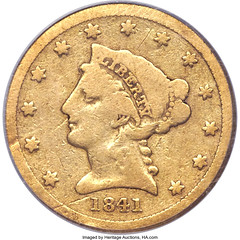
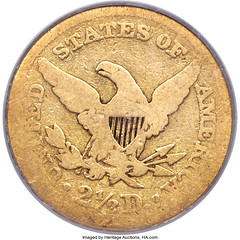
"Little Princess" Quarter Eagle is a Royal Rarity Despite Its Humble Condition
One of the most famous US rarities is a small and otherwise unassuming coin--the 1841 $2 1/2 gold piece, or Quarter Eagle. Known as the "Little Princess," a charming nickname given to this coin in the early 1900s, US Coin collectors are excited when an example in any grade comes to market.
Heritage Auctions will be offering an amazing piece in the Aug. 3-9 U.S. Coin Sale that circulated heavily, only to be eventually identified by a collector as a rarity after many years of use in commerce. On the coin grading scale of 1 to 70, this coin grades only a 4, meaning that this piece was not discovered for its true potential until long after it was struck in 1841! Given the prices that any 1841 Quarter Eagle will go for today, it is hard to imagine this small gold coin being ignored until a lucky collector realized what they had in their pocket.
Heritage Auctions' catalogers explain more of the back story of these pieces:
"Dubbed the ‘Little Princess' since at least the 1950s, this issue has been the subject of an inordinate amount of research, especially in recent years, in an attempt to uncover the mystery of its coinage. Mint records are silent on the coinage of these pieces, despite the need to balance the bullion accounts at the end of every fiscal year. Of the 14 to 18 examples known to exist today, most have distinct prooflike characteristics, and a few are unquestioned proofs. Others are in various states of impairment, showing evidence of mishandling and wear. Traditionally, the 1841 quarter eagles have all been considered proofs, since they all come from the same die pair. However, modern thinking on this topic is that a few pieces were struck as proofs, and then a small number of pieces were struck without special occasion using the same dies. The coinage may have been recorded under the totals for 1840 or 1842, depending on when the 1841 coins were struck. Debate concerning this issue is not yet resolved.
What is certain about the 1841 quarter eagle is that it is a major rarity. Our roster of known specimens tallies just 16 pieces (which may include one or two duplications or omissions). Of these, three are in institutional collections and not available to collectors. Few of the privately held specimens have appeared at auction in recent years, and most show various degrees of wear from circulation. The present example is the most worn example known.
This piece was last certain to have appeared publicly in a January 1969 Rarcoa sale, although it may also have been the coin in Abner Kreisberg's June 1970 sale. It was previously from the Edwin Hydeman Collection (Kosoff, 3/1961). Wear is extensive, although both sides are relatively smooth with uniform honey-gold patina. A linear mark to the left of the date and a small rim mark near star 2 serve as pedigree markers, although this coin also stands apart from the other known specimens as the only piece with a partially worn away reverse rim: 2:00 to 10:00. The obverse rim is sharp. This is one of just two 1841 quarter eagles with CAC approval, adding to its appeal.
While some collectors may view this piece as the "affordable" example of the issue because of its grade, the truth is that any example of this date is immeasurably important since it is unlikely that another will appear at auction any time soon. Moreover, the singularity of this coin in its given grade, and the fact that it has been so many decades off of the market, leaves the door wide open for feverish bidding comparable to that garnered by higher-grade specimens. We are privileged to be able to offer this piece, and we encourage collectors to approach the auction of this famous rarity prepared for competition."
See it for yourself here:
1841 $2 1/2 PR4 PCGS. CAC. JD-1, High R.6....
(https://coins.ha.com/itm/proof-liberty-quarter-eagles/1841-2-1-2-pr4-pcgs-cac-jd-1-high-r6/a/1318-3967.s)

ATOCHA BOLIVIAN PHILIP IV SILVER BAR
Heritage is also offering a massive Bolivian Philip IV silver bar recovered from the wreck of the Atocha. Here's the press release. -Editor
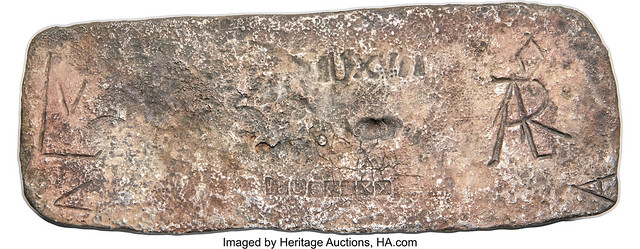
Own a Giant Silver Bar Rescued From The Watery Depths After 300+ Years
The ship Nuestra Senora de Atocha, a Spanish treasure ship, sunk off the Florida Keys in 1622 after the heavy-laden boat was struck by a hurricane. Filled with precious metal bars and coins as well as gems, indigo, and tobacco from Spanish trade, the ship was so full of treasure that it took two months by mule to load it all onto the boat before its journey began! With this precious and heavy cargo weighing it down, the boat was no match for a dangerous hurricane. It sunk Sept. 6, 1622, losing all but 5 of 265 crew members and passengers and its precious cargo in the process.
While the Spanish government tried to recover the Atocha's treasure, they were unsuccessful. They were not able to locate the ship, which lay underwater for over 300 years before any notable developments occurred.
In 1969, Mel Fisher and a group of treasure hunters began to search for the long-lost Atocha. They eventually discovered it in 1985, producing a huge cache of coins, precious metals, and gems that came up from the depths over 350 years later. After a few more years of legal proceedings, Mel Fisher reached a deal with the State of Florida and the Supreme Court to sell the treasure. This is considered to be the most valuable shipwreck ever recovered.
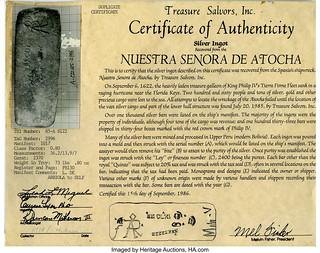 While several years have gone by since the original sale of the Atocha's recovered treasures, pieces from the ship are occasionally available at auction. They come up only infrequently these days and are always popular when available. Heritage will be offering a fabulous, large-scale bar recovered from the shipwreck in the Aug. 5-7 2020 World Coin auction! This bar is an enormous 73 troy pound size, plus it comes with a certificate of provenance.
While several years have gone by since the original sale of the Atocha's recovered treasures, pieces from the ship are occasionally available at auction. They come up only infrequently these days and are always popular when available. Heritage will be offering a fabulous, large-scale bar recovered from the shipwreck in the Aug. 5-7 2020 World Coin auction! This bar is an enormous 73 troy pound size, plus it comes with a certificate of provenance.
Check it out here:
Bolivia: temp. Philip IV silver Atocha Shipwreck Recovery Bar of 73 troy lb 0.80 troy oz. ND, ...
(https://coins.ha.com/itm/bolivia/bolivia-temp-philip-iv-silver-atocha-shipwreck-recovery-bar-of-73-troy-lb-080-troy-oz-nd-/a/3085-30073.s)

THOSE ENIGMATIC S.C. KINGMAN COUNTERSTAMPS
Bill Groom shared with us this excerpt of his article on an enigmatic counterstamp soon to be published in Talkin' Tokens, the journal of the National Token Collectors Association. Thanks! -Editor
PUNCHLINES: Those Enigmatic S.C. Kingman Counterstamps
by Bill Groom
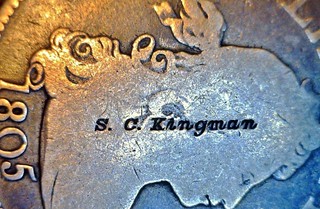 In his book, Merchant and Privately Countermarked Coins, 2003, Dr. Gregory Brunk cataloged the S.C. Kingman counterstamps as # K-221. He noted that this “enigmatic stamp” was small, well executed and of the sort seen on watch cases, jewelry, etc. (N.B. - these stampings are in italics). Brunk listed but four examples, including a 1794 half cent, an early large cent, a Hard Times token and a 1652 Pine Tree Shilling. In 1999, Rulau had listed the same four specimens as Hard Times tokens. Rulau cited speculation by collector, Arvid O. Johnson, that Kingman may have been “an early numismatist who marked his specimens.” Rulau went on to ask, “Was there such a collector?'
In his book, Merchant and Privately Countermarked Coins, 2003, Dr. Gregory Brunk cataloged the S.C. Kingman counterstamps as # K-221. He noted that this “enigmatic stamp” was small, well executed and of the sort seen on watch cases, jewelry, etc. (N.B. - these stampings are in italics). Brunk listed but four examples, including a 1794 half cent, an early large cent, a Hard Times token and a 1652 Pine Tree Shilling. In 1999, Rulau had listed the same four specimens as Hard Times tokens. Rulau cited speculation by collector, Arvid O. Johnson, that Kingman may have been “an early numismatist who marked his specimens.” Rulau went on to ask, “Was there such a collector?'
Since Russ Rulau posed that question, twenty-plus years ago, a number of the Kingman counterstamps have surfaced. Many of these stamps appear on rare coins, which added credence to Arvid Johnson's suspicion. Below is shown an as yet unlisted specimen from this writer's collection ....
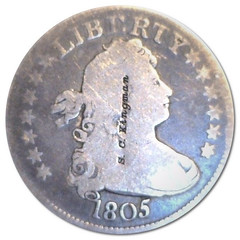
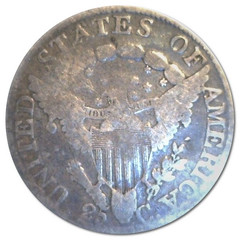
The style and positioning of this counterstamp suggested a personal touch; perhaps, that it was applied to some product for which the issuer took pride of ownership. Searching for products that were stamped by an S.C. Kingman, a nineteenth century target rifle was found that was sold by the Amoskeag Auction Co. in 2019 ....
There now appears to be a preponderance of circumstantial evidence that Samuel Clayton Kingman was the issuer of the S.C. Kingman counterstamps. Samuel fits the profile suggested by Arvid O. Johnson who speculated that the issuer was a coin collector. While Samuel's coin counterstamp has yet to be precisely matched on one of his firearms or patents, we now know that he applied a similar stamp to target rifle. A great many machinists utilized personal counterstamps for a variety of purposes. As Samuel was a highly skilled machinist, it's quite plausible that he would use a stylized mark such as this, consisting of upper and lower-cased letters, in italics.
While the majority of the S.C. Kingman stamps appear on coins dated well prior to 1840, this writer has seen the stamp on an 1855 Flying Eagle Cent, a pattern coin. One of the stamped coins is an 1830 Bust Half in virtually mint condition; coincidentally, the year of Samuel's birth. Considering that Samuel was born in 1830, he'd have been but a teenager at the close of the Hard Times era in 1844. Samuel more than likely created his stamp when he was working as a machinist in the 1850's; this, during the heyday of counterstamp issuance. So, Rulau's having listed this as a Hard Times issue is quite unlikely. Indeed, some of Samuel's coin stampings may even be post Civil War.
For more informstion on the National Token Collectors Association, see:
https://tokencollectors.org/

MAN WINS 1983 ROYAL MINT CONTEST - IN 2020
A new collector in England got a nice surprise from the Royal Mint after contacting them about a 1983 National Coin Week competition. -Editor
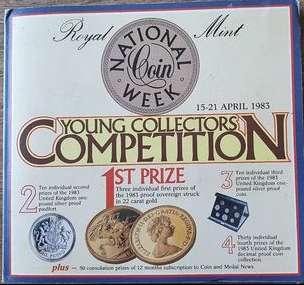 A coin collector from Tunbridge Wells was shocked to win a prize from a kids competition that the Royal Mint ran almost 40 years ago.
A coin collector from Tunbridge Wells was shocked to win a prize from a kids competition that the Royal Mint ran almost 40 years ago.
Warren Light, who lives near Grosvenor Park in the town, has only been an avid numismatist for a year but has an extensive and rare collection.
He regularly creates videos for his YouTube channel devoted to the hobby.
Warren says his favourite 50p design is one dedicated to Professor Stephen Hawking, as his own father had been diagnosed with motor neurone disease.
"It's only been about a year I've been collecting, I guess I was looking for something that I could collect as a hobby or pastime - I looked at a couple of things and just happened to come across a post on Facebook one day, an advert for coins.
"I had no idea of how many there were or anything like that and then I looked into it and was like 'Wow there's so many'.
The hobby led Warren to purchase an old folder online: "I bought a 1983 year set on eBay and it came through with some information included with it - a National Coin Week young coin collector's competition and it was dated 15th of April 1983.
"It's a folder that was empty at the time and the idea was that they would have to collect all of the shillings from 1947 to 1980."
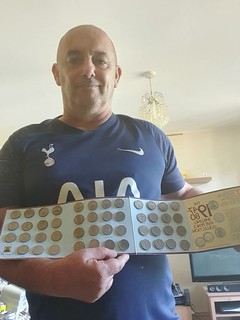 "I thought it would be a nice thing for me to actually fill the folder up."
"I thought it would be a nice thing for me to actually fill the folder up."
After filling his folder, Warren took the chance and got in touch with the Royal Mint: "I completed it and just for a bit of fun, a bit tongue in cheek really, I thought 'I'll email the Mint, to send some photographs of it and say that I've just finished it'.
"I put something on the email along the lines of 'I wondered if you had any prizes that were left unclaimed from 37 years ago?'"
Mr Light forgot all about the email but was delighted to receive a response a few weeks later.
The Royal Mint was pleased to hear about his achievement and how it had helped his mental health, in addition, they said: "As a gesture of goodwill we'll send you a small something in the post."
Not expecting anything grand, Warren went about his day-to-day life as normal but received a knock at the door yesterday (August 6) and received a parcel from the Royal Mint.
He said: "It was amazing, I didn't expect that - I opened it up and it was the 2020 year set.
"I totally was gobsmacked, it was unbelievable. When they said a gesture of goodwill I was expecting maybe a 50p coin but it's actually two year sets. It's all the normal coins but all the commemorative coins as well."
The set which retailed for around £60 online, is worth over £100, he says, if the coins were sold individually due to some of the rare additions to the collection.
Addressing the staff at the Royal Mint, he said: "I'd like to give a massive thank you, it really did leave me speechless."
Great story. Kudos to the Royal Mint for their public relations. -Editor
To read the complete article, see:
I entered a Royal Mint competition from 37 years ago and still won an amazing prize
(https://www.kentlive.news/news/kent-news/entered-royal-mint-competition-37-4405996)
ROYAL MINT COMMEMORATES MAYFLOWER 400TH
The Royal Mint has issued a coin commemorating the quadricentennial of the voyage of the Mayflower. It was designed by Chris Costello, a Boston-based member of the U.S. Mint's Artistic Infusion Program. -Editor
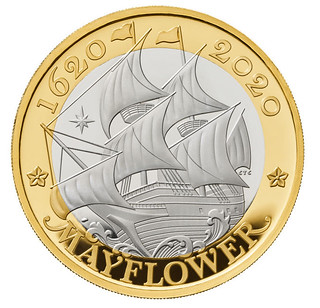 When 102 passengers sailed on the Mayflower from Plymouth, England, on 16 September 1620, their sights were set on a fresh start. They landed in Plymouth Bay over three months later and by spring, just under half of those who had landed in the New World had survived. The original ‘Thanksgiving' feast was held that autumn, after their first successful harvest, and the spirit of the Mayflower pilgrims endures in this national celebration to this day.
When 102 passengers sailed on the Mayflower from Plymouth, England, on 16 September 1620, their sights were set on a fresh start. They landed in Plymouth Bay over three months later and by spring, just under half of those who had landed in the New World had survived. The original ‘Thanksgiving' feast was held that autumn, after their first successful harvest, and the spirit of the Mayflower pilgrims endures in this national celebration to this day.
The epic story of the journey of the Mayflower is told through a £2 coin design by US designer Chris Costello.
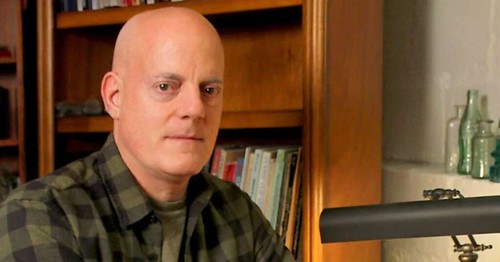
“The process of this design began with historical research and visits to the museums in Plymouth, Massachusetts, then I formulated visions in my mind of what this coin would look like. Many of the features and details of the ship were imaginary… There is a bit of mythical interpretation of the Mayflower story, since nobody really knows what the ship actually looked like. I wanted to create a romantic view with stylized waves that contrasted with the precarious position of the ship in rough seas, thus making an iconic and memorable design; a contemporary coin with subtle traditional beauty that both British and Americans would appreciate and want to own as a keepsake in memory of this historic event.”
To read the complete article, see:
Mayflower
New Horizons
(https://www.royalmint.com/our-coins/ranges/annual-sets/2020-annual-coin-sets/discover/mayflower/)
For more information, or to order, see:
A £2 Coin Commemorating 400 Years Since the Voyage of the Mayflower
(https://www.royalmint.com/our-coins/events/mayflower/)
To read other articles, see:
Mayflower 400 Celebrated with UK Coin Design
(https://www.theamerican.co.uk/pr/ne-Mayflower-Anniversary-Coin)
Royal Mint releases Mayflower anniversary £2 coins
(https://www.coinworld.com/news/precious-metals/royal-mint-releases-mayflower-anniversary-2-pound-coins)
For more about Chris Costello, see:
https://chriscostello.design/
Lou Golino informs me that:
"The U.S. Mint will release a gold reverse proof coin and silver reverse proof medal in the fall for the Mayflower anniversary. Both were added to the product schedule recently, but the specific release date and designs have not yet been revealed.
It is also possible there may be a joint US Mint-Royal Mint product, but there is no news yet on that front. I will have a feature in the November issue of Coin World on world coins issued for the anniversary."

WILL THE PENNY SURVIVE CORONAVIRUS?
Len Augsburger passed along this New York Times piece on the fate of the cent. Thanks. -Editor
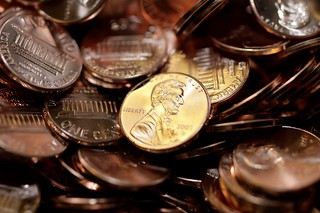 A nationwide coin shortage caused by the coronavirus pandemic has revived a debate: Is now the time to eliminate the penny?
A nationwide coin shortage caused by the coronavirus pandemic has revived a debate: Is now the time to eliminate the penny?
During lockdowns, consumers have stayed home and avoided emptying their piggy banks of coins in exchange for paper money. Shoppers have also opted to rely on credit and debit cards instead of touching cash.
With coins in short supply, the Federal Reserve formed a U.S. Coin Task Force, which will make recommendations on ways to cope with the shortage.
The shortage has led to renewed discussions about the fate of the penny, which has seen its purchasing power fall because of inflation while its production costs have risen.
Sunde White, a 46-year-old small-business owner in San Francisco, said the coin shortage was one more reason to retire the penny.
“I hate pennies,” said Ms. White, adding that they are so useless that she usually throws them on the ground when she gets them back as change. “They're so stupid.”
Even before the coin shortage, she already priced her greeting cards and coloring books at 50 cents or $1 increments for sales at festival stands to save the inconvenience of having to use pennies, she said.
Canada stopped making pennies in 2012, following other countries, including Britain and Australia, which already abandoned their smallest-denomination coins. Canada got rid of pennies for reasons that also apply in the United States: They are not very useful, with too many sitting in jars, and they cost more to make than they are worth.
But the movement to eliminate pennies faces significant opposition.
Some people support the penny for sentimental reasons. It was one of the first coins made by the Mint after it was established in 1792.
Another reason, offered by Americans for Common Cents, an advocacy group that provides research for Congress on the value of the penny, is particularly pertinent during a pandemic: Older pennies are made mostly of copper, which is antimicrobial.
The argument for getting rid of the penny, said N. Gregory Mankiw, an economics professor at Harvard University, has only gotten stronger over the decades, as inflation has suppressed the penny's purchasing power. Still, he said he did not think any changes would happen soon.
“Of all the issues we face, this is probably not a front burner one at this moment,” Professor Mankiw said.
Congress, rather than the Treasury or the Federal Reserve, has the authority to decide whether to retire the coin, and past legislative attempts have struggled to gain traction. The biggest change was in 1857, when Congress discontinued the half cent, which was unpopular at the time.
I'm not sure "revived a debate" is the correct phrase - to me, it seems like this debate is never-ending; I've been hearing calls for the demise of the cent at least since 1974. As the Professor said, it's not now a "front burner" issue; it rarely has been. -Editor
To read the complete article, see:
Will the Penny Survive Coronavirus? Some Hope Not
(https://www.nytimes.com/2020/07/29/business/coin-shortage-penny.html)

THIS ISN'T AMERICA'S FIRST COIN SHORTAGE
The current coin shortage is a far cry from a full blown coin disappearance, which happened in the U.S. during the Civil War when rising specie prices drove silver and gold coins (and ultimately copper coins, too) out of circulation. This article references the 1862 specie panic; the ANA's Doug Mudd gets a quote, too. Here's an excerpt. -Editor
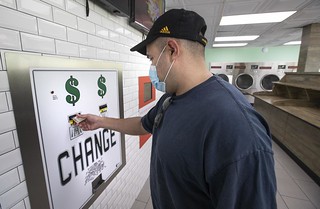 A laundromat operator imploring friends and relatives to trade their stashes of quarters for his dollar bills. A restaurant offering customers free drinks instead of nickels and dimes. Supermarkets issuing pennies' worth of store credit. A woman filling her purse with coins so she can pay in exact change.
A laundromat operator imploring friends and relatives to trade their stashes of quarters for his dollar bills. A restaurant offering customers free drinks instead of nickels and dimes. Supermarkets issuing pennies' worth of store credit. A woman filling her purse with coins so she can pay in exact change.
The COVID-19 pandemic has caused a coin shortage, and it's hitting small-business owners, big retailers and everyday shoppers — especially those who don't have credit or debit cards — in ways big and small.
The main way coins circulate through the economy is via store transactions and coin recyclers, according to the U.S. Mint. But as the coronavirus spread, stores closed and visits to essential retailers plunged.
That means coins are stuck inside people's homes.
When stores need coins, they turn to banks. If the request is more than what the bank has on hand, it can relay that order up the supply chain to the Federal Reserve, the U.S. Treasury and, finally, the U.S. Mint. But when one part of the chain is disrupted, it slows the entire process.
“You had a breakdown in the system because of the closing of the stores and banks,” said Douglas Mudd, curator and museum director of the American Numismatic Association's Edward C. Rochette Money Museum in Colorado Springs, Colorado. “And when it started up again, there was a bit of an overdemand.”
“Lower-income consumers tend to transact more in cash,” said Adrienne Harris, professor of the practice at the University of Michigan and former special assistant to President Obama for economic policy. “It makes things harder for low-income consumers to get the very basic things they need.”
Even before the coin shortage, some businesses wary of handling cash during the coronavirus era were asking customers to use only card or contactless payment methods. That renewed debate over the merits and disadvantages of a so-called cashless society.
During a recent shopping trip to a Smart & Final store in California's San Fernando Valley, Michael Knapp's total bill came to $36.75. He paid $40 in cash, which he always uses because he doesn't have a credit or debit card. He had hoped to get the change in quarters so he could use them to do laundry, but store employees told him they could not give him even one.
In the past, “quarters were always something you could find,” said Knapp, 64.
Knapp ended up getting the change in store credit. He said he's not sure what he'll do if the coin shortage continues. As for his laundry, he happened to wash a lot of clothes right before the shortage, so he's OK — for now.
This isn't America's first coin shortage.
One notable one was during the Civil War, when Americans hoarded coins out of fear, as well as concerns about the value of newly introduced paper money, according to the publication Coin World. Congress then passed a law allowing people to use postage stamps as currency, which subsequently led to a run on post offices, said Rebecca Spang, professor of history at Indiana University, where she teaches courses on the history of money.
Stamps at the time had adhesive backs, making it more likely that they stuck together in a wallet. So months later, the U.S. government started printing what's known as postal currency — a bill-shaped paper smaller than a business card that had an image of a stamp, along with the denomination.
That coin shortage lingered for decades, largely ending by the 1890s, Spang said. Others followed from time to time, including one in the 1960s caused by surges in demand.
To read the complete article, see:
Free drinks, store credit and cries for help: How we're handling the coin shortage
(https://roanoke.com/business/free-drinks-store-credit-and-cries-for-help-how-were-handling-the-coin-shortage/article_2dad7063-79ff-5489-b043-61a62b8851bb.html)
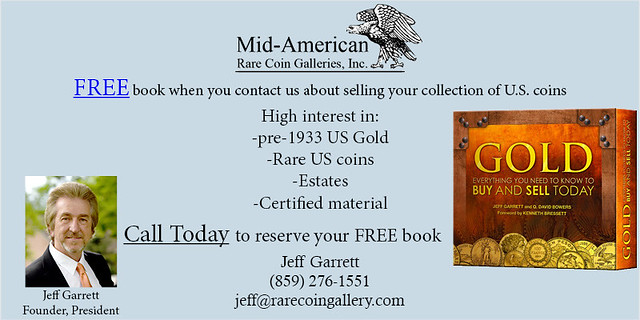
VIRGINIA CHICK-FIL-A COIN DRIVE
Ask and ye shall receive. Len Augsburger also passed along this article about a Virginia Chick-fil-A's quickly successful coin drive. -Editor
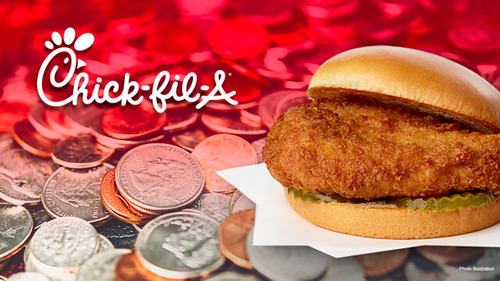
A Virginia-based Chick-fil-A has ended its food-for-coins promotion after it received a surplus of coin rolls from the community.
The Chick-fil-A of Wards Road in the city of Lynchburg launched a coin drive on Saturday, which provided a free meal voucher and $10 in cash to customers who brought in coin rolls of equal value, some of whom used their exchanged money for chicken, fries and other treats. However, the promo was short-lived, lasting only five days thanks to the generosity of the city's local residents and out-of-state Chick-fil-A fans.
Customers who brought in more than $10 in coins received a dollar-to-dollar match in paper money in addition to meal vouchers.
“Event is over!!! Because of the overwhelming response from the community we have received ALL the change we need and then some!! Wow,” the Lynchburg franchisee wrote in a Facebook post that showed its coin haul on Wednesday. “Thank you!! You guys are awesome!! Our event is now over.”
“We had such an overwhelming response on social media, it took off pretty quickly and even went viral with multiple media and networks,” said Carrie Wright, a director of strategic development at Chick-fil-A, in a phone call with FOX Business. “We got a ton of support from the community and we actually got people drive as far away as North Carolina, which was about a two-hour drive to our little city here in Lynchburg, Virginia.”
The Wards Road restaurant ended up having customers line up bright and early at 8 a.m. to give away their change. And by Wright's estimate, between 350 and 400 people showed up to provide their monetary support through spare change.
On a national level, there is a coin shortage due to supply chain disruption caused by the coronavirus pandemic, the Federal Reserve System wrote in a statement issued on Monday.
According to the government agency, there are enough coins in the U.S. but circulation has slowed down and reduced inventories since Americans are still limiting their trips outside.
To read the complete article, see:
Virginia Chick-fil-A ends food-for-coins promo after 'overwhelming response'
(https://www.foxbusiness.com/money/virginia-chick-fil-a-ends-food-coins-promo)

POLAND ISSUES BATTLE OF WARSAW BANKNOTE
The National Bank of Poland has issued a note commemorating the 1920 Battle of Warsaw. -Editor
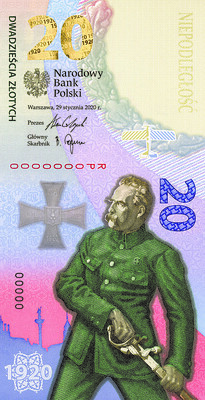
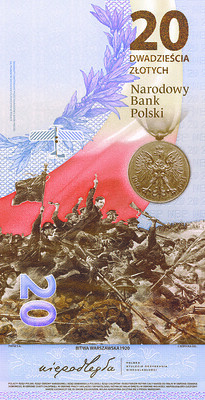
A new collectors' edition of 20 zloty banknotes to commemorate the 1920 Battle of Warsaw have been released by the National Bank of Poland.
The banknote's design will include a depiction of Marshal Józef Pilsudski and a painting of the battle by Jerzy Kossak.
August 13th-25th will mark the 100th anniversary of the victorious clash between the newly formed army of the Second Polish Republic and the Red Army which was marching west to bring the Bolshevik revolution to Europe.
Many historians consider the Polish-Soviet war (February 1919 – March 1921), and especially the Battle of Warsaw, to be a key moment in European history – Edgar Vincent D'Abernon, British politician, called it one of 20 battles that decided the fate of the world. The unexpected victory halted the westward advance of Communism.
The banknote depicting this extraordinary moment was designed by Justyna Kopecka in a vertical layout.
The front features a silhouette of Marshal Józef Pilsudski, a key commander of the battle, in a pose taken from Kazimierz Mankowski's painting “The Year 1920”. The banknote's back depicts the battle itself, based on the Jerzy Kossak's ”Miracle of the Vistula”.
Kalwat said: “The painting represents a symbolic scene - priest Ignacy Skorupka leading an attack by soldiers from voluntary formations. The entire design is complemented by a wreath of laurel leaves, a commemorative medal for the war 1918-1921, as well as a fragment of a government proclamation "Homeland in Danger" of 5 August 1920.”
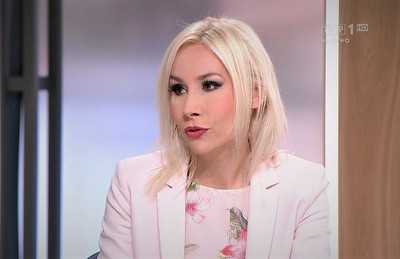
The banknote was designed by Justyna Kopecka who also designed last year's 19 zloty collector's note to commemorate the 100th anniversary of the Polish Security Printing Works (PWPW).
To read the complete article, see:
Beautiful collectors' notes issued to commemorate 1920 Battle of Warsaw
(https://www.thefirstnews.com/article/beautiful-collectors-notes-issued-to-commemorate-1920-battle-of-warsaw-14662)
NEW TRINIDAD AND TOBAGO POLYMER BANKNOTES
New polymer notes are being introduced in Trinidad and Tobago. -Editor
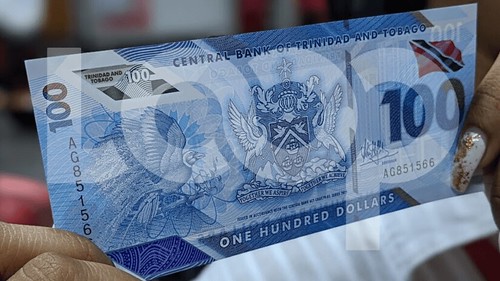
Trinidad and Tobago Polymer $100 Banknote
The Central Bank on Wednesday unveiled updated concept designs for the new polymer banknote series.
The elements of the refreshed design are consistent with the $100 polymer notes that replaced the old cotton-based notes which ceased to be legal tender on December 31, 2019.
The new bank notes in the $50, $20, $10, $5 and $1 quantities feature T&T Coat of Arms, the national flag above the bills' denominations and a clear window which can be seen from the front and back of the note.
The new details released on Wednesday show the designs on the anterior of the bills. The designs released in February this year featured the obverse only.
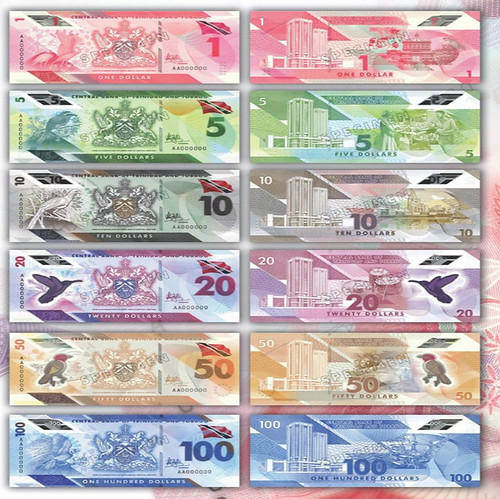
While the bills retain some of the elements of the current cotton-based notes in circulation, there are notable changes.
The old cotton-based bills will continue to be legal tender at least until the end of 2021. The new polymer notes will co-circulate with the existing notes during the demonetisation period.
To read the complete article, see:
Central Bank releases updated polymer designs
(https://www.looptt.com/content/central-bank-releases-updated-polymer-designs)
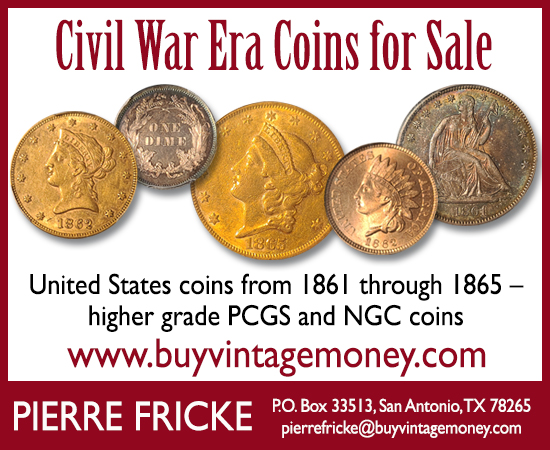
FEATURED WEB PAGE: YOUNG NUMISMATISTS
This week's Featured Web Page is the Facebook home of the American Association of Young Numismatists.We are an organization that educates Young Numismatists, who are the future of the hobby.

www.facebook.com/American-Association-of-Young-Numismatists-118701826190/

